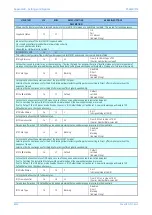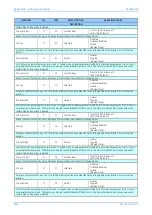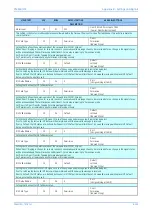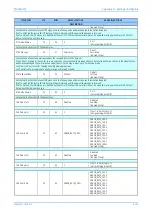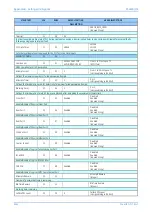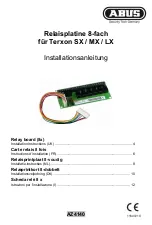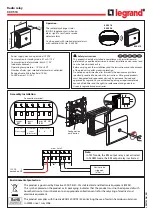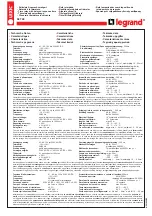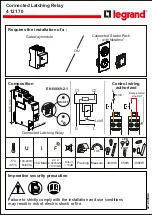
P54A/B/C/E
Appendix B - Settings and Signals
P54xMED-TM-EN-1
B159
MENU TEXT
COL
ROW
DEFAULT SETTING
AVAILABLE OPTIONS
DESCRIPTION
Alarm Level
20
81
0.25
From 0.05 to 0.95 in steps of 0.01
[Courier Number (percentage)]
This setting is the % of errored/lossed messages allowed before the Time out flag is set for the affected channel. This will also initiate the
comm Fail timer.
IM1 Cmd Type
20
82
Permissive
Direct
Permissive
[Indexed String]
Setting that defines the operative mode of the received InterMiCOM_1 signal.
When ‘Direct’ tripping is chosen, for security reasons 2 consecutive valid messages have to be received before a change in the signal status
will be acknowledged. That will impose an additional 1-2 ms delay comparing to ‘Permissive’ mode.
Set ‘Direct’ in Direct Transfer Tripping (Intertripping) applications.
Set ‘Permissive’ to accommodate any Permissive or Blocking scheme.
IM1 FallBackMode
20
83
Default
Default
Latched
[Indexed String]
Setting that defines the status of IM1 signal in case of heavy noise and message synchronization being lost.
If set to Latching the last valid IM1 status will be maintained until the new valid message is received.
If set to Default, the IM1 status, pre-defined by the user in IM1 Default Value cell will be set. A new valid message will replace IM1 Default
Value, once the channel recovers.
IM1 DefaultValue
20
84
0
0 or 1
[Unsigned Integer(16 bit)]
Setting that defines the IM1 fallback status.
IM2 Cmd Type
20
85
Permissive
Direct
Permissive
[Indexed String]
Setting that defines the operative mode of the received InterMiCOM_2 signal.
When ‘Direct’ tripping is chosen, for security reasons 2 consecutive valid messages have to be received before a change in the signal status
will be acknowledged. That will impose an additional 1-2 ms delay comparing to ‘Permissive’ mode.
Set ‘Direct’ in Direct Transfer Tripping (Intertripping) applications.
Set ‘Permissive’ to accommodate any Permissive or Blocking scheme.
IM2 FallBackMode
20
86
Default
Default
Latched
[Indexed String]
Setting that defines the status of IM2 signal in case of heavy noise and message synchronization being lost.
If set to Latching the last valid IM2 status will be maintained until the new valid message is received.
If set to Default, the IM2 status, pre-defined by the user in IM2 Default Value cell will be set. A new valid message will replace IM2 Default
Value, once the channel recovers.
IM2 DefaultValue
20
87
0
0 or 1
[Unsigned Integer(16 bit)]
Setting that defines the IM2 fallback status.
IM3 Cmd Type
20
88
Permissive
Direct
Permissive
[Indexed String]
Setting that defines the operative mode of the received InterMiCOM_3 signal.
When ‘Direct’ tripping is chosen, for security reasons 2 consecutive valid messages have to be received before a change in the signal status
will be acknowledged. That will impose an additional 1-2 ms delay comparing to ‘Permissive’ mode.
Set ‘Direct’ in Direct Transfer Tripping (Intertripping) applications.
Set ‘Permissive’ to accommodate any Permissive or Blocking scheme.
IM3 FallBackMode
20
89
Default
Default
Latched
[Indexed String]
Setting that defines the status of IM3 signal in case of heavy noise and message synchronization being lost.
If set to Latching the last valid IM3 status will be maintained until the new valid message is received.
If set to Default, the IM3 status, pre-defined by the user in IM3 Default Value cell will be set. A new valid message will replace IM3 Default
Value, once the channel recovers.
IM3 DefaultValue
20
8A
0
0 or 1
[Unsigned Integer(16 bit)]
Setting that defines the IM3 fallback status.
IM4 Cmd Type
20
8B
Permissive
Direct
Permissive
[Indexed String]
Summary of Contents for P4A
Page 2: ......
Page 20: ...Contents P54A B C E xviii P54xMED TM EN 1 ...
Page 27: ...CHAPTER 1 INTRODUCTION ...
Page 28: ...Chapter 1 Introduction P54A B C E 2 P54xMED TM EN 1 ...
Page 38: ...Chapter 1 Introduction P54A B C E 12 P54xMED TM EN 1 ...
Page 39: ...CHAPTER 2 SAFETY INFORMATION ...
Page 40: ...Chapter 2 Safety Information P54A B C E 14 P54xMED TM EN 1 ...
Page 52: ...Chapter 2 Safety Information P54A B C E 26 P54xMED TM EN 1 ...
Page 53: ...CHAPTER 3 HARDWARE DESIGN ...
Page 54: ...Chapter 3 Hardware Design P54A B C E 28 P54xMED TM EN 1 ...
Page 86: ...Chapter 3 Hardware Design P54A B C E 60 P54xMED TM EN 1 ...
Page 87: ...CHAPTER 4 SOFTWARE DESIGN ...
Page 88: ...Chapter 4 Software Design P54A B C E 62 P54xMED TM EN 1 ...
Page 99: ...CHAPTER 5 CONFIGURATION ...
Page 100: ...Chapter 5 Configuration P54A B C E 74 P54xMED TM EN 1 ...
Page 120: ...Chapter 5 Configuration P54A B C E 94 P54xMED TM EN 1 ...
Page 121: ...CHAPTER 6 CURRENT DIFFERENTIAL PROTECTION ...
Page 122: ...Chapter 6 Current Differential Protection P54A B C E 96 P54xMED TM EN 1 ...
Page 149: ...CHAPTER 7 AUTORECLOSE ...
Page 150: ...Chapter 7 Autoreclose P54A B C E 124 P54xMED TM EN 1 ...
Page 207: ...CHAPTER 8 CB FAIL PROTECTION ...
Page 208: ...Chapter 8 CB Fail Protection P54A B C E 182 P54xMED TM EN 1 ...
Page 219: ...CHAPTER 9 CURRENT PROTECTION FUNCTIONS ...
Page 220: ...Chapter 9 Current Protection Functions P54A B C E 194 P54xMED TM EN 1 ...
Page 244: ...Chapter 9 Current Protection Functions P54A B C E 218 P54xMED TM EN 1 ...
Page 247: ...CHAPTER 10 VOLTAGE PROTECTION FUNCTIONS ...
Page 248: ...Chapter 10 Voltage Protection Functions P54A B C E 222 P54xMED TM EN 1 ...
Page 261: ...CHAPTER 11 FREQUENCY PROTECTION FUNCTIONS ...
Page 262: ...Chapter 11 Frequency Protection Functions P54A B C E 236 P54xMED TM EN 1 ...
Page 268: ...Chapter 11 Frequency Protection Functions P54A B C E 242 P54xMED TM EN 1 ...
Page 269: ...CHAPTER 12 MONITORING AND CONTROL ...
Page 270: ...Chapter 12 Monitoring and Control P54A B C E 244 P54xMED TM EN 1 ...
Page 300: ...Chapter 12 Monitoring and Control P54A B C E 274 P54xMED TM EN 1 ...
Page 301: ...CHAPTER 13 SUPERVISION ...
Page 302: ...Chapter 13 Supervision P54A B C E 276 P54xMED TM EN 1 ...
Page 312: ...Chapter 13 Supervision P54A B C E 286 P54xMED TM EN 1 ...
Page 323: ...CHAPTER 14 DIGITAL I O AND PSL CONFIGURATION ...
Page 324: ...Chapter 14 Digital I O and PSL Configuration P54A B C E 298 P54xMED TM EN 1 ...
Page 336: ...Chapter 14 Digital I O and PSL Configuration P54A B C E 310 P54xMED TM EN 1 ...
Page 337: ...CHAPTER 15 FIBRE TELEPROTECTION ...
Page 338: ...Chapter 15 Fibre Teleprotection P54A B C E 312 P54xMED TM EN 1 ...
Page 354: ...Chapter 15 Fibre Teleprotection P54A B C E 328 P54xMED TM EN 1 ...
Page 355: ...CHAPTER 16 ELECTRICAL TELEPROTECTION ...
Page 356: ...Chapter 16 Electrical Teleprotection P54A B C E 330 P54xMED TM EN 1 ...
Page 366: ...Chapter 16 Electrical Teleprotection P54A B C E 340 P54xMED TM EN 1 ...
Page 367: ...CHAPTER 17 COMMUNICATIONS ...
Page 368: ...Chapter 17 Communications P54A B C E 342 P54xMED TM EN 1 ...
Page 439: ...CHAPTER 18 CYBER SECURITY ...
Page 440: ...Chapter 18 Cyber Security P54A B C E 414 P54xMED TM EN 1 ...
Page 457: ...CHAPTER 19 INSTALLATION ...
Page 458: ...Chapter 19 Installation P54A B C E 432 P54xMED TM EN 1 ...
Page 471: ...CHAPTER 20 COMMISSIONING INSTRUCTIONS ...
Page 472: ...Chapter 20 Commissioning Instructions P54A B C E 446 P54xMED TM EN 1 ...
Page 513: ...CHAPTER 21 MAINTENANCE AND TROUBLESHOOTING ...
Page 514: ...Chapter 21 Maintenance and Troubleshooting P54A B C E 488 P54xMED TM EN 1 ...
Page 530: ...Chapter 21 Maintenance and Troubleshooting P54A B C E 504 P54xMED TM EN 1 ...
Page 531: ...CHAPTER 22 TECHNICAL SPECIFICATIONS ...
Page 532: ...Chapter 22 Technical Specifications P54A B C E 506 P54xMED TM EN 1 ...
Page 558: ...Chapter 22 Technical Specifications P54A B C E 532 P54xMED TM EN 1 ...
Page 559: ...APPENDIX A ORDERING OPTIONS ...
Page 560: ...Appendix A Ordering Options P54A B C E P54xMED TM EN 1 ...
Page 565: ...APPENDIX B SETTINGS AND SIGNALS ...
Page 566: ...Appendix B Settings and Signals P54A B C E P54xMED TM EN 1 ...
Page 790: ...Appendix B Settings and Signals P54A B C E B224 P54xMED TM EN 1 ...
Page 835: ...APPENDIX C WIRING DIAGRAMS ...
Page 836: ...Appendix C Wiring Diagrams P54A B C E P54xMED TM EN 1 ...
Page 849: ......






